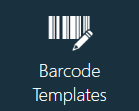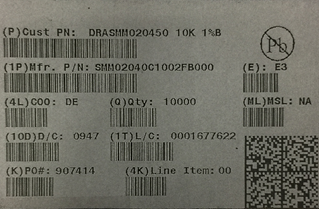About barcode templates

Barcode templates are used to define masks or segmented information in the form of a barcode. Defining these masks lets you scan barcoded data and automatically parse it into separate fields for use or input in Production or Logistics operations. You might use this approach to validate that a scanned barcode is in the correct format in production labels or to parse data into multiple fields for Material Capture templates from a complex 2D barcode from a vendor label.
Barcode templates define the format and fields contained in barcodes used throughout the FactoryLogix system. Depending on your needs, barcode templates can be:
Fixed length where each barcode scanned contains a specific number of characters
Fixed segment length where each segment of a barcode contains a specific number of characters
Delimited by a specific character between segments, regardless of length
As you add barcode segments, you can associate them with a FactoryLogix field for validation purposes. For example, if the first five characters of a scanned barcode have an association of "Assembly", then that portion of the barcode will be validated against the Assembly Name of the current assembly.
Creating barcode templates is important for a number of reasons. Without a barcode template, FactoryLogix can't make use of "Serial Number Ranges" if it doesn't know which portion of the barcode to increment.
Linear (1D) barcodes
Linear or 1D (one-dimensional) barcodes represent data in the widths (lines) and the spacing of parallel lines. Examples of 1D barcodes are Code 39, Code 128, and UPC. 1D barcodes have these characteristics:
Hold fewer than 85 characters (symbology-specific character limit)
Create a wide barcode
May be more difficult to scan from phone and tablet cameras

2D barcodes
Two-dimensional (2D) barcodes may have patterns of squares, dots, hexagons and other geometric patterns. While maintaining a small size, these barcode types hold much more data than 1D barcodes. 2D barcodes can hold hundreds of characters. Some examples of 2D barcodes are Data Matrix, QR Code, and PDF 417. 2D barcodes have these characteristics:
Encode/hold hundreds of characters
Require a 2D barcode scanner
Create a physically smaller barcode than 1D
Are easily scanned from phone and tablet cameras
Data Matrix is an efficient, two-dimensional (2D) barcode symbology that uses a small area of square modules with a unique perimeter pattern. The perimeter pattern helps a barcode scanner determine the cell locations and decode the symbol.

Example
In the following example of a vendor label, each piece of data has its own 1D barcode and human-readable data. There is also a single 2D Datamatrix barcode that contains all of this data in one convenient form. FactoryLogix can make use of these complex barcodes as long as the barcode segments are already defined.

